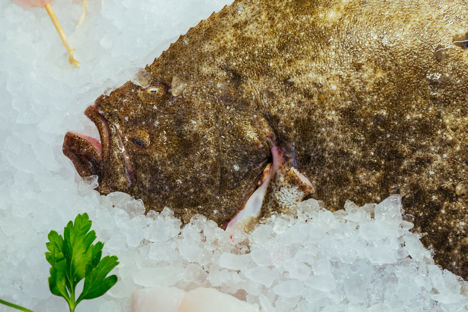Turbot is a large, sandy-coloured flatfish that, alongside Dover sole, lemon sole, halibut, plaice and brill, is one of the most readily consumed flatfish in the UK. It’s fished in the North Atlantic and the Mediterranean Sea, and farmed in countries including France and Spain, but supplies are limited so it commands high prices, making it a luxurious option for restaurants and a treat for most households.
Turbot is well liked for good reason: one fish provides four decent sized fillets; the flesh – which is stark white and firm with large flakes – holds together during cooking; and it has a subtle taste-of-the-sea flavour
What to look for when buying turbot
There are other species of flounder available that fishmongers may try to sell you, but turbot is arguably superior and European turbot more so than its Greenland cousin. Buy it whole, in fillets or as steaks. In some restaurants you’ll see turbot cheeks on the menu; these come from the head of the fish. While wild is regarded as tastier than farmed the Marine Conservation Society (MSC) recommend farmed for sustainability. If turbot isn’t available, Dover sole makes an excellent substitute.
As with all fish it is important to choose the freshest quality of turbot before buying. Turbot should be firm to the touch and free of an unpleasant fishy odour. The eyes should be clear, the fins should be intact and the gills should be bright red.
When choosing fillets of turbot, it is harder to tell how fresh the fish is – look for flesh with no discolouration.
How to cook turbot
Like all white fish, turbot should be cooked with care and skill. Because turbot flesh is quite delicate, wet heat cooking methods such as steaming, poaching or cooking en papillote are preferable, though not crucial. Dry heat methods such as pan-frying and grilling add flavour but should be implemented gently.
To know when turbot is cooked, insert a sharp knife into the thickest part of the flesh – if it’s cooked through the knife will come out hot to the touch. The flesh should also feel springy.
Baking or roasting turbot whole is one of the best – if not the best – way of cooking this deluxe fish. Cooking turbot whole with the bones is always preferable as it adds flavour to the fish. Salt seals in moisture, making it an excellent way to bake turbot - making the fish succulent but not salty. When cooking turbot whole, ensure that it’s been gutted, with gills and scales removed or this can impart an unpleasant bitter taste. But don't forget turbot is a big fish, so make sure your roasting tin can fit the whole turbot in! See How to roast a whole turbot for more.
Whilst it’s possible to barbecue turbot, it’s such a prized (and pricey) fish that it’s debatable whether this less refined method of cooking is appropriate. If you do barbecue, en papillote is preferable to retain the moistness of the flesh.
You can buy fillets of turbot or if you want to practise your knife skills buy a whole fish and fillet it yourself.
The most common way of cooking turbot fillets is to pan fry them, until golden brown and crispy, this can be done in a matter of minutes. The skin is normally removed before frying.
If possible, keep the fillet of turbot on the bone like Robert Thompson's Pan-roasted turbot to ensure best results.
What turbot goes with
Aim for light sauces that don’t overwhelm, such as hollandaise, white wine, Champagne or something herby like parsley or dill. Because of its luxurious reputation, turbot will often be served with a lobster dressing or oysters. Other fitting accompaniments include roasted fennel, cauliflower and celeriac purée.
Get in touch
Please sign in or register to send a comment to Great British Chefs.


